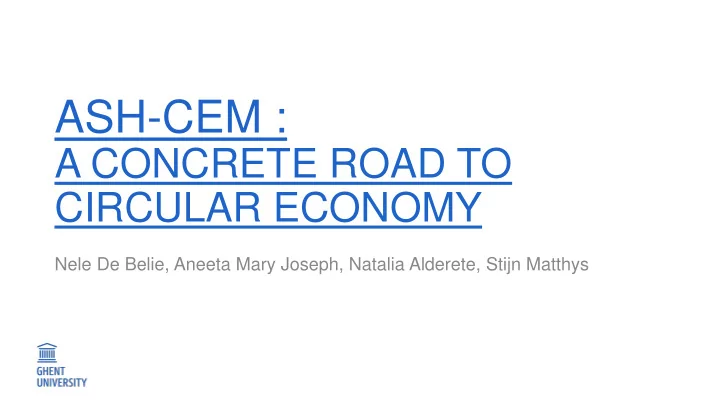

ASH-CEM : A CONCRETE ROAD TO CIRCULAR ECONOMY Nele De Belie, Aneeta Mary Joseph, Natalia Alderete, Stijn Matthys
OVERVIEW ̶ SCMs and treated incineration ashes ̶ ASH-CEM for CEM II (Supplementary Cementitious Material) ̶ ASH-CEM for CEM I (Raw material for clinker) ̶ Conclusions
SCM s AND TREATED INCINERATION ASHES Processed MSWI ash for use as SCM and raw material
4 TON CONCRETE PER PERSON PER YEAR Partially replace cement by another reactive material SCM = secondary cementitious materials (which are triggered by the cement reaction)
WHAT CHARACTERISTIC SHOULD THIS MATERIAL HAVE? Be a by-product (Prevents mining) Have quantity available (Enough to meet demand) Have local availability (Less transportation) Have a reduced pre-treatment requirement (Secondary pollution and emissions) Be reactive (Allows more replacement of clinker) Conform to leaching standards (Eliminate contamination risks) Municipal Solid Waste Incineration (MSWI) ash after treatment in view of use as SCM Processed Incineration Ash (PIA)
BOTTOM ASH FROM WASTE INCINERATION
MUNICIPAL SOLID WASTE MANAGEMENT Transformation into raw material, e.g. SCM After Extraction of metals Cleaning, sieving and seizing Milling to powder Be a by-product (Prevents landfilling & avoids mining of primary resources) Feasibility to treat the ash (Cost & environmental effectiveness as raw material)
AVAILABILITY AS A RESOURCE Quantity available (Enough to meet demand) Locally available (Less Transportation) 0.24 billion tonnes MSW generated ~20% incinerated ~50 million tons bottom ash generated in EU Widely distributed (e.g. Belgium)
̶ ̶ ̶ REACTIVITY SCREENING AS SCM condenser Modified Chapelle test (Conventional method) 1g of PIA reacts at 90°C in water with 2g of CaO for 16h 350 mg calcium hydroxide consumption per g of SCM plug thermometer distilled water Erlenmeyer CaO stirrer FA NP sample PIA Li et al., 2018
̶ ̶ ̶ ̶ REACTIVITY SCREENING AS SCM R³ calorimetry test (novel method) TC 257-TRM PIA reacts with calcium hydroxide in presence of alkalis and sulphates Heat released is measured (reaction at 40°C) ~250J heat released per g of SCM in 7 days Reactive (Similar to fly ashes from round robin tests) FA NP PIA Li et al., 2018
POSITIONING IN THE ASH-CEM PROJECT Metal extraction and further Treated ash in = MSWI ash treatment by Indaver different size fractions Raw material for ASH-CEM treatment Aggregate for cement clinker (removal of Al and concrete production production milling) ASH-CEM binder for SCM ASH-CEM technology
ASH-CEM AS CEMENT REPLACEMENT Processed MSWI ash used as SCM
ASH-CEM TREATMENT Two alternatives to conventional alkali treatment: 1. Submerging in water at 105°C till it is dried Waste heat in incineration plant can be used 2. Slow grinding + sieving Cheap and efficient Pre-treatment requirement (Limit secondary pollution and emissions)
ELEMENTAL ALUMINIUM SET-UP for quantification
EFFECT OF PRE-TREATMENT ON EXPANSION Cement mortar, w/b 0.5 Corrugated tubes to measure expansion
PERFORMANCE ON CONCRETE LEVEL ̶ Mixes ̶ Compressive strength ̶ Chloride Ingress ̶ Leaching Also tensile strength, creep, shrinkage, carbonation, water absorption, freeze- thaw, etc. was verified and proven to be of equivalent performance with benchmark concrete.
̶ ̶ ̶ ̶ MIXES Mix 1 – With CEM I 52.5 N, w/b – 0.5 Mix 2 – With CEM II B-V 32.5R : Same aggregate - cement - water content as Mix 1 Mix 3 – Simple replacement without mix optimisation Mix 4 – With 80% CEM I 52.5R + 20% PIA : Mix proportions optimised for same compressive strength as Mix 1 at 28 days; w/b – 0.45
• Mix 1 – CEM I 52.5 N, w/b – 0.5 COMPRESSIVE STRENGTH • Mix 2 – CEM II B-V 32.5R, w/b – 0.5 • Mix 4 – 80% CEM I 52.5R + 20% PIA , w/b – 0.45 (optimized) Strong case for OPC replacement with SCM ! Mix 4 – optimised mix design for same 28 day compressive strength – more strength development at 90 days Mix 2 – Even with cement replacement, almost comparable strength at 90 days
CHLORIDE INGRESS • Nord test (Accelerated chloride exposure) • Exposed to 165 g/L chloride solution (~5.5 times more concentrated than sea water) after 28 and 90 days of sample curing • Chloride content at different depths for 7 weeks exposure measured by potentiometric titration
• Mix 1 – CEM I 52.5 N, w/b – 0.5 CHLORIDE INGRESS • Mix 2 – CEM II B-V 32.5R, w/b – 0.5 • Mix 4 – 80% CEM I 52.5R + 20% PIA , w/b – 0.45 (optimized) Chloride exposure after 28 d curing: Chloride exposure after 90 d curing: – chloride ingress: mix 4 mix 2 mix 1 – chloride ingress: mix 4 < mix 2 < mix 1
LEACHING Leaching test of all mixes crushed to <4mm conducted according to CMA/2/II/A.9.1 Conform to leaching standards
WHAT CHARACTERISTIC SHOULD THIS MATERIAL HAVE? Be a by-product (Prevents mining) Have quantity available (Enough to meet demand) Have local availability (Less Transportation) Have a reduced pre-treatment requirement (Secondary pollution and emissions) Be reactive (Allows more replacement of clinker) Conform to leaching standards (Eliminate contamination risks) Municipal Solid Waste Incineration (MSWI) ash after treatment in view of use as SCM Processed Incineration Ash (PIA)
ASH-CEM FOR CLINKER PRODUCTION Processed MSWI ash as clinker raw meal replacement
LAB SINTERING PROCEDURE Pellets – Mixing of Chemical raw 5 mm dia & Characterization materials length 1450 o 0 50 100 150 200 250 Time (min)
THREE CEMENTS SUCCESSFULLY PRODUCED AT LAB SCALE – XRD 3 optimised mixes COMPOSITION with three size fractions (milled) of PIA PIA content ~5% in all raw mixes 6/15 Mix 2/6 Mix 0/2 Mix
̶ ̶ ̶ ̶ CONCLUSION Processed Incineration Ash (PIA): Promising material to be used in cementitious products Reactivity makes the ash suited as SCM Needs pre-treatment but can be optimised for minimum secondary pollution and energy footprint Comparable strength and durability properties with conventional concrete can be achieved
short road to doom or long road to sustainability?
ASH-CEM : A CONCRETE ROAD TO CIRCULAR ECONOMY Nele De Belie, Aneeta Mary Joseph, Natalia Alderete, Stijn Matthys
Recommend
More recommend